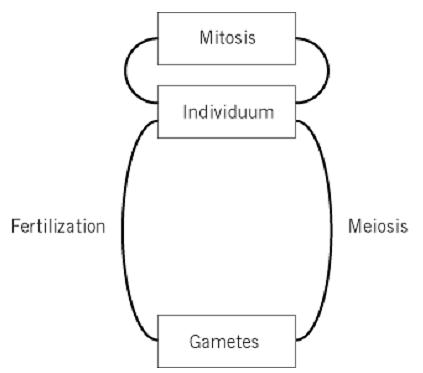


 النبات
النبات
 الحيوان
الحيوان
 الأحياء المجهرية
الأحياء المجهرية
 علم الأمراض
علم الأمراض
 التقانة الإحيائية
التقانة الإحيائية
 التقنية الحيوية المكروبية
التقنية الحيوية المكروبية
 التقنية الحياتية النانوية
التقنية الحياتية النانوية
 علم الأجنة
علم الأجنة
 الأحياء الجزيئي
الأحياء الجزيئي
 علم وظائف الأعضاء
علم وظائف الأعضاء
 الغدد
الغدد
 المضادات الحيوية
المضادات الحيوية|
Read More
Date: 23-12-2015
Date: 15-5-2016
Date: 4-6-2021
|
Animal Reproduction
Reproduction is the process of genetic transfer to the next generation. In animals, reproduction involves two sexes, meiosis and multicellularity (1). Thus, reproduction in animals is different from reproduction in prokaryotes, such as bacteria. A further characteristic of animal reproduction is that animals are mobile and therefore able to spread their own genes in a much more efficient way than, for example, plants can do. Another characteristic that is related to this subject is the necessity for sexual reproduction. Unlike plants or bacteria, animals have no vegetative reproduction pathways. The rare parthenogenic events that occur in some insects like bees and sometimes in frogs are very special exceptions and cannot be considered to be the rule. Also, apart from some fishes (which can be polyploid) or certain stages after reproductive events in some insects, most animals tend to be diploid individuals. During gametogenesis, the diploid genotype has to be reduced in order to provide germ cells that are haploid; these events, therefore, involve both mitotic and meiotic divisions. The ajoining of the maternal and paternal nuclei during karyogamy results in the creation of a diploid individual (Fig. 1).

Figure 1. Diagrammed relationship between the individual, gametes, meiosis, mitosis, and fertilization. As a rule, mammals are diploid, whereas their gametes are reduced during meiosis to a haploid stage. After a male and a female gamete join during fertilization, a diploid individual is generated. Cells other than the germ cells of the individual divide mitotically.
In animals, there is a strict division between somatic and germ line cells. Even after just the first stages of cell division following fertilization, germ cells are determined, and they migrate to the primordial urogenital tract, where they develop according to their genetic constitution into either spermatogonia or oogonia. Somatic cells are always diploid, apart from the G2 and M phase of the cell cycle, in which the genome is temporarily tetraploid. There are no certain stages in animals and in the animal reproductive cycle as there are in plants during which the whole individual undergoes a haploid or a diploid phase. Although there is a strict separation of somatic and germ cells, neither cell type acts completely independently of the other. The phenotype, ie, the morphology and the ethology of animals, is most certainly determined by actions that are regulated by the germ cells. For instance, puberty causes animals to change their phenotype. In frogs, maturation can easily be seen in the metamorphosis of tadpoles to mature frogs. Most of these developmental processes are, in terms of animal reproduction, determined by the action of hormones. For this reason, it is not surprising that a number of hormone receptors are present, not only in organs that are directly related to reproductive events but also in organs and somatic tissues in which no direct link with reproductive activity is presupposed. This is, for example, the case with the estrogen receptor, which is expressed in a number of tissues.
Animal reproduction is not restricted to the events of the production of germ cells, reduction to a haploid stage, fertilization, and early development of the embryo. Regarding certain aspects of reproduction, some homology even to reproduction in plants can probably be found. A very important and unique aspect of reproduction in animals, however, is the event of giving birth. Interestingly, there are vast differences among species. The predominant one can be seen when comparing animals in which extracorporal fertilization is the rule (as in spawning frogs) with more sophisticated species, like chordates. In extracorporal fertilization, only the release of the mature gametes into a liquid medium (in most cases, water) has to be regulated. From then on, gamete interaction is directed by protein-protein interactions, as genetic control by the nucleus has not been observed. Chemotactic attraction then directs the motile gamete, which is normally that of the male, to the oocyte. In species that give birth, not only the gametogenesis, behavioral, and ethological aspects have to be considered to achieve reproductive success, but the hormonal machinery to induce labor, milk secretion, and changes in behavior are also important. This is of sufficient interest to elucidate the molecular basis for the development of these metabolic events.
Animal reproduction also comprises the events that have to take place after birth of the offspring, known as brood care. Although brood care is an important element in most of the primates, in other species the intensity of the brood care varies. In species with extracorporal fertilization, the intensity of brood care can be extremely low, as can be seen in frogs or in sea urchins. In sticklebacks, the brood care involves at least the construction of a nest, whereas, in birds, brood care also entails feeding the offspring. An interesting exception to this is the cuckoo, which has developed a mechanism that allows it to abuse the brood care of other singing birds. In higher species, brood care also involves the phase of imprinting and teaching social behavior. This is extremely important in terms of animal reproduction because it can be shown that artificially promoted faulty imprinting can lead to animals that have lost the drive to mate. The brood care does not occur in plants or in bacteria and is therefore a characteristic of reproduction in animals, especially in higher mammals with a sophisticated social structure.
References
1. Ruvinsky A (1997) Acta Biotheor 45, 127–141.



|
|
|
|
"عادة ليلية" قد تكون المفتاح للوقاية من الخرف
|
|
|
|
|
|
|
ممتص الصدمات: طريقة عمله وأهميته وأبرز علامات تلفه
|
|
|
|
|
|
|
المجمع العلمي للقرآن الكريم يقيم جلسة حوارية لطلبة جامعة الكوفة
|
|
|